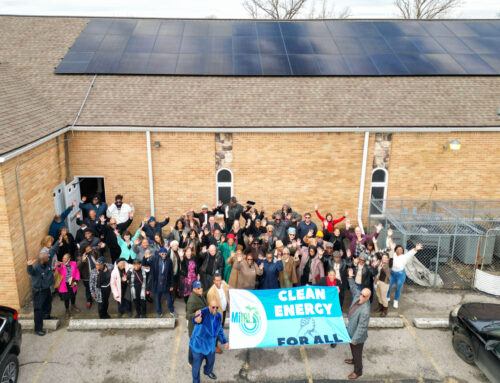Tech-Backed Dems May Endanger California’s Clean Energy Laws
May 14, 2025
Tech-Backed Dems May Endanger California’s Clean Energy Laws
In the California legislature, Democrats are pushing a bill that could hand control of the state’s energy markets to the pro–fossil fuel Trump administration. Expert analyses suggest the bill could jeopardize California’s trailblazing clean energy laws.

Amid ever-worsening climate disasters, Silicon Valley–backed Democrats are pushing a bill that could hand control of California’s energy markets to the fossil fuel–happy Trump administration. Tech companies supporting the legislation say it’s needed to meet rising energy demands (fueled in part by artificial intelligence data centers), but expert analyses suggest the bill could increase emissions across the West and jeopardize the state’s trailblazing clean energy laws.
As one of the largest electricity consumers and most progressive regulators in the country, if California makes such a move it could risk worsening climate conditions across the arid West and endanger the state’s clean energy goals, which have been a bellwether for renewable energy policy across the nation.
The bill would allow California to relinquish control of its state-run energy markets, under which an independent nonprofit organization facilitates the bulk sales of electricity generation and transmission across 80 percent of the state, and enter into a regional energy market with various Western states. The bill’s authors say this will result in fewer greenhouse gas emissions and lower energy costs for Californians.
The new multistate energy structure would be governed by the Federal Energy Regulatory Commission (FERC), an independent federal agency that regulates interstate electricity transmission and over which Donald Trump has recently asserted more direct control.
Project 2025, the ultraconservative policy blueprint for Trump’s administration that he has been closely following, calls for the Energy Department to “refocus FERC” to “no longer allow it to favor special interests and progressive causes” and prioritize fossil fuels.
If the bill is enacted, it could cause greenhouse gas emissions to rise across the drought-stricken West and jeopardize California’s clean energy laws, according to a California Senate analysis and studies reviewed by the Lever. The analysis, which was authored by California Senate Judiciary Committee staffers, is explicit in its warning: “Under this bill, California would open the state up to federal challenges.”
“Despite the stated benefits, there are dangers in moving forward with this bill,” the analysis states:
These dangers are even greater now that President Trump has put a target on California’s green energy laws and directed the United States Attorney General to find ways to curtail our state’s climate change efforts and to identify opportunities to challenge our state policies through various legal angles.
The bill comes after wildfires ravaged parts of Los Angeles in January and as the Golden State and the West continue to deal with historic megadroughts.
State senator Josh Becker (D), coauthor of the bill, represents Silicon Valley and has received more than $42,000 in campaign donations since June 2021 from industry groups and tech companies supporting the bill, according to records reviewed by the Lever. Additionally, disclosures reveal that Becker has up to $3.4 million invested in various tech and artificial intelligence companies and received $100,000 for advising a quantum computing company.
Becker’s coauthor, Sen. Henry Stern (D), has received $16,000 since December 2021 in campaign donations from Google and Amazon, which both support the bill, disclosures show. Stern represents Los Angeles suburbs just north of neighborhoods incinerated by climate-fueled wildfires in January, and in 2018, Stern’s house and 1,600 other structures were destroyed in a wildfire that burned 97,000 acres across his district.
“There are much easier ways to sell out to Big Tech than this bill,” Stern noted in an email response to the Lever:
This bill is an effort to save money by sharing power during times of peak demand, replacing costly fossil peaker plants with out-of-state renewable power. I haven’t spoken to any of those companies about this bill, and they haven’t attended a single meeting I’ve been in. I’ve been working on it with environmental organizations like [the Natural Resources Defense Council] and [the Environmental Defense Fund] since 2021.
Becker’s office declined to comment on the bill.
California governor Gavin Newsom (D), who has close personal ties and financial connections to Big Tech companies, supported a similar energy-market bill in the past.
Consumer Watchdog, a consumer advocacy group and a critic of the California bill, said in a report on the matter that “data centers and their need for more energy to power the AI revolution are driving the rush” for California to enter into a regional energy market. Data centers’ power demands are consuming limited resources and jacking up consumers’ electricity rates.
“This is about Trump making smart people do dumb things,” Jamie Court, president of Consumer Watchdog, told the Lever. “This is all about [people] feeling like we need to bend towards the industries that Trump’s favorable to and meet them halfway. You can’t meet the oil industry halfway or the energy industry halfway because they’ll gobble you up.”
You Can Check Out, but You Can Never Leave
Established in 1997 after the state restructured and deregulated its electricity industry to introduce more competition, the California Independent System Operator is a public-benefit nonprofit corporation that manages energy transmission and bulk energy sales from power plants and renewable sources to various electrical companies, which then sells the electricity to consumers across the state.
The California Independent System Operator’s unique structure has helped develop complex, competitive energy markets, in which buyers and sellers bid and sell wholesale electricity. This dynamic, market-driven structure has allowed the state to integrate renewables and historic amounts of battery storage faster than other states. In 2024, 54 percent of California’s electricity was renewable — and the state managed to go one hundred days using nothing but renewable power.
But California, which is home to Silicon Valley and a number of tech companies whose systems demand an ever-increasing amount of electricity, has also faced a number of blackouts and energy catastrophes since 2000.
A January report by the California Legislative Analyst’s Office, an independent government research arm, found that the Golden State’s energy demands will increase by more than 75 percent by 2045, due in part to “growing demands from data centers and artificial intelligence,” resulting in higher energy costs for the average consumer.
If passed, Becker and Stern’s bill would allow the California Independent System Operator to enter into a regional energy market while still maintaining control over its transmission, energy sourcing, and clean energy policies. Entering into the regional market could bring down consumer costs by allowing the state to export excess renewable energy, import cheaper energy from a “wider set of Western renewable resources,” and other actions, the authors state.
Becker and Stern point to a study by the Brattle Group, a consulting firm, that found gas generation in the state could drop by 31 percent and the use of solar and wind energy sources could increase by 10 percent by reducing the number of hours these renewables are purposefully shut down to avoid overloading the grid. Another study found that the energy system would be less stressed, potentially leading to fewer blackouts.
“As we move toward achieving California’s 100 percent clean energy goals, we must look at all possible solutions to reduce costs, improve reliability, and cut emissions,” Becker said in a press release, referencing California’s commitment to run solely on renewable energy by 2045. “[The bill] strikes that balance by unlocking the benefits of a regional energy market while safeguarding California’s critical public policy priorities. It offers a win-win scenario for California — achieving cleaner energy, more reliable power, and real savings for ratepayers.”
The bill is supported by a number of prominent environmental groups, including the Environmental Defense Fund and the Natural Resources Defense Council, because they say it will “enhance grid reliability, promote renewable energy integration, and reduce overall costs to consumers.”
The bill would set rules around how such a regional energy market would operate, like mandating that it’s run by a nonprofit corporation, receive consumer input, hold public hearings, and make greenhouse gas emission data public, similar to how the California Independent System Operator runs now. The bill also provides “a procedure for unilateral withdrawal by any participant with reasonable prior notice and without any further approvals.”
“The reason those of us in the climate movement have been working on this tricky issue for so long is precisely because of the Trump risk,” Stern said. “If he forces other states to double down on coal and other fossil fuel sources, and California doesn’t open its grid to more shared power, the low-cost renewable projects throughout the West will die.”
However, according to the bill’s critics, a state senate analysis, and multiple federal court rulings, if California enters into the regional market, the state’s clean energy policies and autonomy could be at risk.
The California Senate analysis of the bill highlights two legal arguments of concern: the Dormant Commerce Clause, which gives the federal government the authority to regulate interstate commerce; and the preemption doctrine, also known as the Supremacy Clause, which allows federal law to supersede state law.
“Opposition to this bill points out that should California laws governing the use of renewable energy be preempted or found to violate the Dormant Commerce Clause, then dirtier forms of energy, such as from coal, could enter into the grid operating in California,” the state senate analysis states.
The California State Senate analysis highlighted a 2016 Eighth Circuit Court of Appeals ruling citing the Dormant Commerce Clause that prevented a Minnesota law governing carbon dioxide emissions from going into effect because it would have imposed similar regulations in other states that were a part of the regional energy market. If California were to join a similar energy market, its carbon-pricing model that has effectively banned coal power in the state could be in jeopardy, the analysis states.
Furthermore, a 2016 US Supreme Court ruling citing the preemption doctrine blocked Maryland, which was part of a regional energy market, from building a new natural gas power plant because the rates offered to Maryland residents would conflict with rates set by the Federal Energy Regulatory Commission, which governs regional energy markets.
Authors of the California bill claim that the Supreme Court ruling would not apply because of certain stipulations placed in the bill.
Critics, however, cite another concern: in order for a state to leave a regional energy market, the Federal Energy Regulatory Commission must sign off on the matter and can place strict conditions that have to be met before the exit is approved.
Consumer Watchdog compared joining a regional market to the Hotel California: “You can check out, but you can never leave.”
Beyond the legal and regulatory challenges California may face, according to the Brattle Group’s study, the bill may even result in higher greenhouse gas emissions across the West.
Big Tech Eyes the Energy Industry
Supporters of the bill include Amazon, Google, Microsoft, and a number of trade associations representing these companies and other tech firms, such as the Data Center Coalition.
Such a regional market would provide these tech companies with a more reliable energy source by allowing a number of power sources from across the region to chip in power, no matter how that energy is made.
In a March 15 comment letter to the Trump administration regarding Trump’s plan to promote artificial intelligence, the Data Center Coalition noted that its industry’s “greatest challenge is timely access to reliable energy.” The coalition added that Trump’s AI plans should “focus on ensuring expedient access to reliable, timely, and affordable energy to secure U.S. leadership in the global digital infrastructure race.”
Amazon, Google, Microsoft, Meta, and other Big Tech companies are Data Center Coalition members, and some have advocated in the past for a Western states regional energy market.
In 2019, Google’s director of operations said that it is “very important” for the company to be involved in regional energy markets. “As we expand our footprint with our data centers and our operations and expand our footprint with renewables . . . I do envision us probably getting involved in more [regional energy markets].”
In 2022, Amazon’s global head of grid modernization said the company would prefer a Western regional energy market, and in 2024, Microsoft’s senior program manager for data center energy wrote that the “path towards greater regional cooperation on electric markets and planning has never been more clear, nor more necessary.”
“Beyond Microsoft’s existing footprint in the Western U.S., Microsoft is continuously evaluating new expansion opportunities in the region to meet the growing demand for digital services,” the data center program manager wrote.
In March, Amazon, Google, Microsoft, the Data Center Coalition and more than thirty-five other groups submitted a letter to the California State Senate stating that the bill is needed to “provide much needed energy affordability benefits to Californians” and that it would “enhance the reliability of California’s power grid by enabling more efficient and coordinated management of energy supply and demand across the Western region.”
Some of the bill’s supporters have also donated to the election efforts of its coauthors, Becker and Stern.
Google and several of its employees have donated more than $18,000 to Becker’s campaign efforts since December 2021, disclosures show. Amazon, which is headquartered in Washington State, donated nearly $11,000 to Becker’s reelection efforts since October 2021, state data shows.
Stern has received more than $10,000 from Google since December 2021 and $5,500 from Amazon since November 2023 for his campaign efforts, records show.
Other groups supporting the bill have spent nearly a quarter of a million dollars since January lobbying on the bill and other issues, according to lobbying disclosures. These groups include “common sense” advocacy group Elevate California, power company Silicon Valley Clean Energy, steel company Pacific Steel Group, and the Boston-based environmental nonprofit Ceres, Inc.
Groups opposed to the bill include the California State Council of Laborers, the District Council of Iron Workers, and the International Brotherhood of Boilermakers. The labor groups wrote a joint letter to the legislature stating that since the bill would not go into effect until 2027, they would like the legislature to see how Trump’s environmental and energy policies unfold before passing such legislation.
“The Trump administration is mounting an assault on our shared commitment to sustainable power generation and is also pressuring the Federal Energy Regulatory Commission to implement the Administration’s new energy directive,” the groups wrote in a joint letter. “The legislature, ratepayers, and the blue-collar workers that power our state deserve this information before rash decisions about policy are made that could have such significant negative consequences.”
“Unleashing American Energy”
Since taking office on January 20, Trump has signed a slew of executive orders directing various agencies to slash environmental protections and juice fossil fuel energy production, some of which directly target states’ ability to regulate their own energy markets.
On April 8, Trump issued an executive order directing the attorney general to identify state laws and policies that are “burdening the identification, development, siting, production, or use of domestic energy resources that are or may be unconstitutional, preempted by Federal law, or otherwise unenforceable.”
Trump singled out California, stating that its laws amount to “radical requirements” that place “impossible caps on the amount of carbon businesses may use.” The executive order also states that the Trump administration is dedicated to “unleashing American energy” by removing barriers to oil, natural gas, coal, hydropower, and other energy productions. That same day, the president signed another executive order calling specifically for an increase in coal production.
This push for increased domestic energy production comes amid growing electricity demands from data centers and other artificial intelligence operations. In another executive order signed April 8, Trump stated that the United States is “experiencing an unprecedented surge in electricity demand driven by rapid technological advancements, including the expansion of artificial intelligence data centers and an increase in domestic manufacturing.”
As the tech industry consumes ever more electricity, Consumer Watchdog warns that consumers will end up paying higher utility bills.
“For data centers that Amazon has been approved to build in the state of Washington alone, the amount of electricity required to run them is the equivalent to the power needed to run nearly 6 million homes, more than the entire country of Chile,” the consumer advocacy group wrote in a report about the bill. “And it will be consumers who will have to pay for this, not the data industry, or utilities.”
The artificial intelligence industry currently uses more energy each year than 16 million households, which has contributed to higher energy bills for American consumers across the country. Furthermore, a senior executive with German tech giant Siemens said there is not enough renewable energy in the world to power data centers.
A December Department of Energy report found that in 2023, US-based data centers accounted for 4.4 percent of all electricity consumption nationwide, more than the total amount used by California households.
One study found that electricity bills for the average consumer could increase by up to 70 percent due to data center energy demands.
“Given that the president’s executive orders precisely target California and what he refers to as our ‘state overreach,’ this is arguably not the year to pass this legislation,” the California Senate analysis states. “It would be prudent to proceed with caution and wait and see how the [US] Attorney General identifies and takes ‘action against state laws . . .’ without giving the Trump Administration another new opportunity upon which to take action against our state’s green energy efforts.”
Search
RECENT PRESS RELEASES
Related Post




